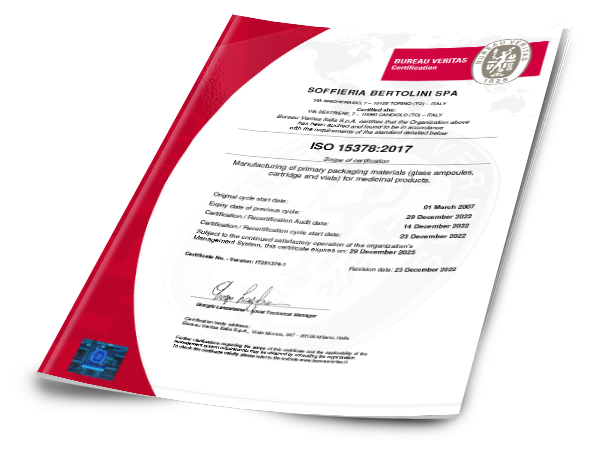SCOPE OF THE INTERNAL SILICONIZATION
- To make the internal glass wall not wettable (hydrophobic behaviour). In this way the full content of drug can be recovered by the final user guaranteeing the correct dosage. Overdosing is no more required.
- To protect the active principle against any glass interaction.
- To improve the efficiency of the freeze-drying process helping the correct cake formation.
- To reduce the glass leaches (especially Aluminum).
INGREDIENTS
Liveo 366®, Dimethicone NF Emulsion or Momentive Oil Emulsion H.
This product has been registered to the Food and Drug Administration (re. Drug Master File No. 1499).
Distilled water.
METHOD
The siliconization process is fully integrated in our manufacturing line and it has been patented in EU, USA and Japan with the support of the Turin Politech.
Our vials manufacturing line is composed by:
- Forming machine
- Transfer line
- Annealing oven
- Silicon injection station
- Silicon curing oven
The diluted silicon emulsion contained in a stainless-steel reservoir, is sprayed inside each vial, standing in horizontal position over a “V-shaped” support, through a multi-jet nozzle fed by an injection system.
A PLC system allows to set very precisely the emulsion quantity required according to the vial size.
A camera system checks the emulsion quantity sprayed inside each vial and activate the automatic rejection of all faulty pieces.
Then, all vials are transferred inside the curing tunnel oven (working at around 500°C).
During the transfer time, the silicon emulsion solvent (water) and the other emulsion components (i. e. surfactants) evaporates while a thin layer of silicon (PDMS) builds-up on the internal wall of the body/shoulder.
EFFECTS
The thin silicon layer on the inner glass wall prevents the contact between the glass and the drug.
SILICONIZATION QUALITY CONTROL
Two methods are mainly used to statistically check in-process the quality of the internal siliconization.
1. Water method: the containers are gradually filled with water; in the meantime, the operator checks the correct meniscus shape (Conform: flat/convex; Not conform: concave);
2. Editio Cantor method: the containers are filled with a milky test emulsion (zinc oxide, sodium alginate, glycerin and water), shaken then turned upside down. All the emulsion must drain out from the vials and kept in this position for 3 minutes. Only few small drops adhering on the internal glass walls are allowed.
LABORATORY ANALYSIS
Soffieria Bertolini in cooperation with the Chemistry Department of the Turin University and the Pharma Science of the Pavia University, is capable to support Customers in the treatment development.
The following studies and analysis can be performed:
Surface behaviour of the cured silicon layer performed with Scanning Electron Microscopy.





